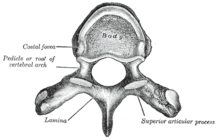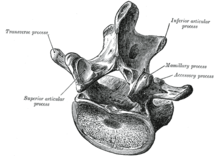Vertebrae (anatomy)
In anatomy, the bony element of the spine is referred to as the vertebra ( Latin vertebra ) . Each vertebra (with the exception of the uppermost cervical vertebra, the atlas ) consists of the vertebral body, the vertebral arch, two transverse processes (one each on the right and left), the spinous process and four articular processes (in humans: two upper and two lower). Some vertebrae have two teat processes (only in thoracic and lumbar vertebrae ) and two additional processes (only in a few mammals on the lumbar vertebrae).
Vertebral bodies
The vertebral bodies ( corpus vertebrae ) are each provided with a cover plate at the poles pointing to adjacent vertebrae. Between these cover plates, adjacent vertebrae are connected to one another by means of a fibrous cartilage with an intervertebral disc and two ligaments ( ligamentum longitudinal anterius and posterius ) with connective tissue . The vertebral body is a supporting and load-bearing molded part of the vertebra.
Vertebral arch
The vertebral arch ( arcus vertebrae ) is a bony component of every vertebra in the spine. It begins on both sides with a "foot" ( Pediculus arcus vertebrae ), which unite in the arch plate ( Lamina arcus vertebrae ).
It arches around the back ( dorsal ) of the vertebral hole ( foramen vertebrale ). The ventral side ( ventral) of the vertebral hole is formed by the vertebral body. The lined-up vertebral holes of the individual vertebrae form the longitudinal vertebral canal (canalis vertebralis) in the spinal column , in which the spinal cord, including meninges and cerebrospinal fluid, is embedded and thus protected against external influences.
The vertebral arches are connected to one another by the vertebral arch joints (facet joints).
Transverse process
The paired transverse process ( processus transversus , also known as the diaphysis) is used to attach ligaments (e.g. ligamenta intertransversaria ) and muscles . In the thoracic vertebrae , the transverse processes also form an articulated connection to the rib of the same number .
The transverse processes of the cervical vertebrae are pierced longitudinally through a hole ( foramen transversarium ), which is usually missing in the seventh cervical vertebra in many mammals. These holes in their entirety form the transverse process canal ( Canalis transversarius ), through which the arteria and vena vertebralis as well as the nervus vertebralis pass.
If there is a blockage , the transverse processes are also rotated and thus narrow the spinal nerve outlet, which can lead to severe pain. In scoliosis (lateral rotation of the spine), too , the transverse processes are considerably rotated and can often only be intercepted with a corset at the beginning - in early childhood (8-10 years of age).
Spinous process
The spinous process ( processus spinosus , also known as neurapophysis) is an extension of a vertebra that starts from the vertebral arch and is directed backwards (dorsally).
The atlas (first cervical vertebra) does not have a spinous process, instead a tuberculum posterius ( tuberculum dorsale ). A special situation can also be seen in the sacrum : Here the spinous processes are fused to form the so-called Crista sacralis median a. Ligaments ( ligamentum interspinale or ligamentum supraspinale ) and some of the back muscles attach to the spinous processes . Like the transverse processes, they form levers that support the action of the connected muscles. You can easily feel them on your back as solid elevations.
Articular processes
The four articular processes ( processus articulares , also known as zygapophyses) form the real joints between the vertebrae. A distinction is made between two upwardly directed (superior) and two downwardly directed (inferior) articular processes, whereby the inferior articular process (postzygapophysis) is connected to the superior articular process (prezygapophysis) of the following vertebra on the same side . In animals, the articular processes are directed forward (cranial) or backward (caudal) due to the horizontal posture and are therefore referred to as the cranial articular process and the caudal articular process .
Teat process
The paired teat process ( processus mamillaris ) occurs only in thoracic and lumbar vertebrae . It sits on the superior / cranial articular process (Netter p. 153/154) and points upwards in humans and forwards in animals and serves as a muscle attachment.
Additional appendix
The additional process ( processus accessorius ) occurs only on the lumbar vertebrae in humans and predatory animals . It is directed downwards or backwards (caudally) in animals and sits at the transition from the vertebral arch to the costal process.
Characteristics of the different types of vortices

Color legend:
-
Cervical vertebra :
- Foramen transversarium ("transverse hole") in the 1st (in ruminants from the 2nd) to the 6th cervical vertebra.
- The spinous process is long and jagged in humans.
- 7 vertebral bodies in humans (the number is constant in all mammals)
-
Thoracic vertebrae :
- The spinous process is long, single-pronged and extends diagonally downward to over the adjacent segment.
- 12 vertebral bodies in humans
-
Lumbar vertebrae :
- pronounced accessory process.
- Costal process ("rib process") present.
- The spinous process is single-pronged and curved downwards.
- 5 vertebral bodies in humans (normally, but by recruiting a sacral vertebra the number can also be 6 -> lumbalization of a sacral vertebra)
-
Sacral vertebrae :
- Processus spinosi are fused into a ridge.
- 5 fused vertebral bodies in humans (normally, but by recruiting a lumbar vertebra the number can also be 6 -> sacralization of a lumbar vertebra)
-
Tail vertebrae :
- 3–5 rudimentary vertebral bodies in humans
Differentiation aid : The size of the vertebral bodies increases (in the area of the cervical, thoracic and lumbar vertebrae) from top to bottom.
Diseases
Vertebral diseases are also known as spondylopathies . See: List of diseases of the musculoskeletal system and connective tissue according to ICD-10 # M45 – M49 Spondylopathies .
Vertebral body replacement
Comminuted fractures of a vertebral body or tumors in the area of the spinal column sometimes require the replacement of a vertebral body with an implant. The stress on these implants is largely unknown. In order to measure it, a standard clinical implant was modified at the Julius Wolff Institute of the Charité Berlin so that the three force and three moment components can be measured in vivo. For this purpose, a telemetry transmitter together with 6 strain sensors and a coil was installed in a hermetically encapsulated manner in the cylinder of the implant. Usually the spine is additionally stabilized with an internal fixator . Several instrumented vertebral body replacement implants were placed in patients and the implant loads were measured during various activities of daily living.
Individual evidence
- ^ Salomon / Geyer / Gille (eds.): Anatomy for veterinary medicine . Enke Stuttgart. 3rd ext. Edition 2015, ISBN 978-3-8304-1288-5 , p. 54.
- ↑ Hendrik Schmidt: Instrumented Vertebral Body , Julius Wolff Institute for Biomechanics and Musculoskeletal Regeneration.
literature
- Hermann Braus: Human anatomy. First volume. Musculoskeletal system. Julius Springer, Berlin 1920.
- Kurt Fleischhauer (Ed.): Macroscopic and microscopic anatomy of humans. 13./14. Edition. Urban & Schwarzenberg, Munich 1985 (founded by A. Benninghoff).
- Rauber , Kopsch : Human anatomy. Textbook and atlas. Thieme, Stuttgart 1987.
- Franz-Viktor Salomon (ed.): Anatomy for veterinary medicine. Enke, Stuttgart 2004, ISBN 3-8304-1007-7
- Herbert Lippert : Textbook anatomy. 6th edition. Urban & Fischer, Munich 2003, ISBN 3-437-42361-4 .
- Werner Platzer: Pocket Atlas of Anatomy. Volume 1. Musculoskeletal system. Thieme, Stuttgart 1991, ISBN 3-13-492006-9 .


